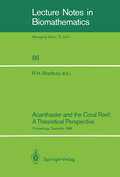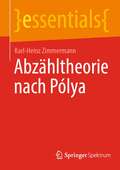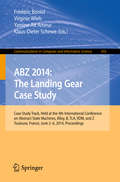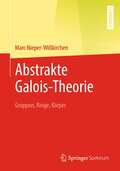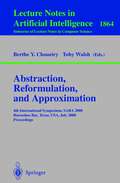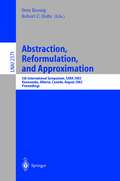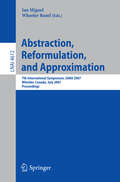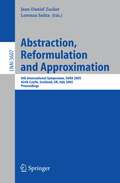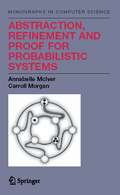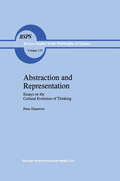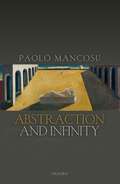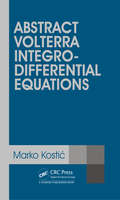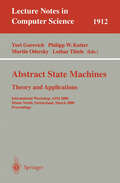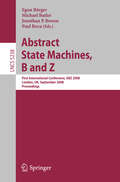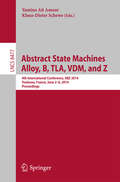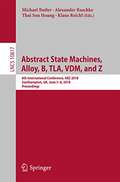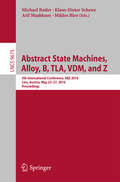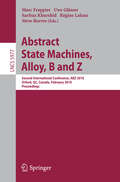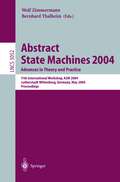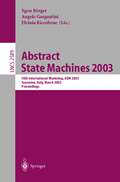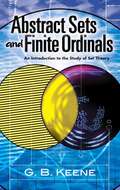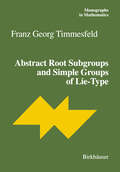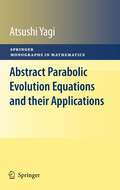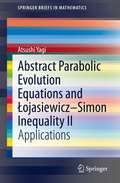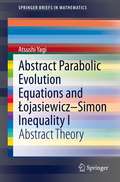- Table View
- List View
Acanthaster and the Coral Reef: Proceedings of a Workshop held at the Australian Institute of Marine Science, Townsville, Aug. 6–7, 1988 (Lecture Notes in Biomathematics #88)
by Roger H. BradburyIn August 1988. the Sixth International Coral Reef Symposium was held in Townsville resulting in an influx of most of the world's coral reef sCientists to the city. We seized this opportunity at the Australian Institute of Marine Science to run a small workshop immediately before the symposium on the outbreaks of the crown-of-thorns starfish. Aeanthaster planei. We invited that small band of mathematicians who had been modelling the phenomenon, (and who may not have normally attended an international meeting so thoroughly dedicated to natural science) to meet with those SCientists who had been been actively working on the phenomenon in the field. John Casti notes in his delightful new book Alternate Realities (Wiley, 1989): 'If the natural role of the experimenter is to generate new observables by which we know the processes of Nature, and the natural role of the mathematician is to generate new formal structures by which we can represent these processes. then the system SCientist finds his niche by serving as a broker between the two. ' I think our book shows the fruits of that brokerage through the wide range of models explored within its pages. the high level of collaboration and interaction across disciplines evident in the individual papers, and in the emerging synthesis that reflects a far deeper understanding of this complex phenomenon than was possible even a few years ago.
Abzähltheorie nach Pólya (essentials)
by Karl-Heinz ZimmermannIm Zentrum dieses essentials steht der gefeierte Abzählsatz von Pólya. Damit lassen sich kombinatorische Objekte mit Symmetrien abzählen, wie etwa Halsketten mit bunten Perlen und Würfel mit gefärbten Seiten, aber auch Graphen und Bäume. Die Gruppentheorie wird dafür benutzt, die Symmetrien der abzuzählenden Figuren zu beschreiben. Darauf aufbauend kann anhand der Operation der jeweiligen Symmetriegruppe auf den gefärbten Figuren die Anzahl der verschiedenen Muster ermittelt werden. Grundlegend hierfür ist das Lemma von Burnside. Aus seiner gewichteten Fassung wird unter Einbeziehung der Zyklenindexpolynome von Symmetriegruppen der berühmte Pólyasche Satz hergeleitet. Einige Beispiele runden die Darstellung ab.
ABZ 2014: Case Study Track, Held at the 4th International Conference on Abstract State Machines, Alloy, B, TLA, VDM, and Z, Toulouse, France, June 2-6, 2014, Proceedings (Communications in Computer and Information Science #433)
by Frederic Boniol Virginie Wiels Yamine Ait Ameur Klaus-Dieter ScheweThis volume contains proceedings of the Case Study Track, held at the 4th International Conference, ABZ 2014, in Toulouse, France, in June 2014. The 11 papers presented were carefully reviewed and selected from numerous submissions. They use different formal techniques: B, ASM, Fiacre. They also propose different kinds of verification such as proof, model checking, test generation, run-time monitoring, and simulation.
Abstrakte Galois-Theorie: Gruppen, Ringe, Körper
by Marc Nieper-WißkirchenIn diesem Lehrbuch wird die moderne, abstrakte Sichtweise auf die galoissche Theorie einsteigertauglich dargestellt. Dazu werden die fundamentalen begrifflichen Abstraktionen der Algebra – Gruppe, Ring und Körper – definiert, erklärt und durch Bezüge zu anderen Bereichen der Mathematik sowie der alltäglichen Anschauung mit Leben gefüllt. Gleichzeitig wird der Anwendungsbereich der elementaren Galois-Theorie erweitert, zum Beispiel von Körpererweiterungen über den rationalen Zahlen zu Körpererweiterungen über beliebigen Körpern. Der Zugang ist konsequent konstruktiv: anstelle von abstrakten Existenzbeweisen treten konstruktive Verfahren, Lösungen algorithmisch zu berechnen. Dies führt zu vielfältigeren Anwendungsmöglichkeiten der Ergebnisse sowie zu einer konzeptionellen Klarheit und einer schärferen Sicht auf die Zusammenhänge. Der Leser wird dadurch an moderne Entwicklungen herangeführt, etwa in der Topostheorie oder der (Homotopie-)Typentheorie, wo eine Sensibilität für konstruktive Schlussweisen zentral ist. Der Inhalt knüpft an das Lehrbuch „Elementare Galois-Theorie“ desselben Autors an, kann aber auch aufbauend auf eher klassischen Einführungen in die Algebra gewinnbringend gelesen werden. Es eignet sich somit gut für eine weiterführende Bachelor-Vorlesung in Algebra, ist aber auch zum vertiefenden Selbststudium gut geeignet. Die zentralen Aussagen werden bereits innerhalb des Textes zusammenfassend und prägnant dargestellt, der Leser wird so zum Innehalten und Reflektieren angeregt und kann Inhalte gezielt wiederholen. Darüber hinaus gibt es am Ende jedes Kapitels eine Kurzzusammenfassung, mit der noch einmal Schritt für Schritt die wesentlichen Argumente nachvollzogen werden können, sowie zahlreiche Übungsaufgaben mit ansteigendem Schwierigkeitsgrad.
Abstraction, Reformulation, and Approximation: 4th International Symposium, SARA 2000 Horseshoe Bay, USA, July 26-29, 2000 Proceedings (Lecture Notes in Computer Science #1864)
by Berthe Y. Choueiry Toby WalshThis volume contains the proceedings of SARA 2000, the fourth Symposium on Abstraction, Reformulations, and Approximation (SARA). The conference was held at Horseshoe Bay Resort and Conference Club, Lake LBJ, Texas, July 26– 29, 2000, just prior to the AAAI 2000 conference in Austin. Previous SARA conferences took place at Jackson Hole in Wyoming (1994), Ville d’Est´erel in Qu´ebec (1995), and Asilomar in California (1998). The symposium grewout of a series of workshops on abstraction, approximation, and reformulation that had taken place alongside AAAI since 1989. This year’s symposium was actually scheduled to take place at Lago Vista Clubs & Resort on Lake Travis but, due to the resort’s failure to pay taxes, the conference had to be moved late in the day. This mischance engendered eleventh-hour reformulations, abstractions, and resource re-allocations of its own. Such are the perils of organizing a conference. This is the ?rst SARA for which the proceedings have been published in the LNAI series of Springer-Verlag. We hope that this is a re?ection of the increased maturity of the ?eld and that the increased visibility brought by the publication of this volume will help the discipline grow even further. Abstractions, reformulations, and approximations (AR&A) have found - plications in a variety of disciplines and problems including automatic progr- ming, constraint satisfaction, design, diagnosis, machine learning, planning, qu- itative reasoning, scheduling, resource allocation, and theorem proving. The - pers in this volume capture a cross-section of these application domains.
Abstraction, Reformulation, and Approximation: 5th International Symposium, SARA 2002, Kananaskis, Alberta, Canada, August 2-4, 2002, Proceedings (Lecture Notes in Computer Science #2371)
by Sven Koenig Robert C. HolteIt has been recognized since the inception of Artificial Intelligence (AI) that abstractions, problem reformulations, and approximations (AR&A) are central to human common sense reasoning and problem solving and to the ability of systems to reason effectively in complex domains. AR&A techniques have been used to solve a variety of tasks, including automatic programming, constraint satisfaction, design, diagnosis, machine learning, search, planning, reasoning, game playing, scheduling, and theorem proving. The primary purpose of AR&A techniques in such settings is to overcome computational intractability. In addition, AR&A techniques are useful for accelerating learning and for summarizing sets of solutions. This volume contains the proceedings of SARA 2002, the fifth Symposium on Abstraction, Reformulation, and Approximation, held at Kananaskis Mountain Lodge, Kananaskis Village, Alberta (Canada), August 2 4, 2002. The SARA series is the continuation of two separate threads of workshops: AAAI workshops in 1990 and 1992, and an ad hoc series beginning with the "Knowledge Compilation" workshop in 1986 and the "Change of Representation and Inductive Bias" workshop in 1988 with followup workshops in 1990 and 1992. The two workshop series merged in 1994 to form the first SARA. Subsequent SARAs were held in 1995, 1998, and 2000.
Abstraction, Reformulation, and Approximation: 7th International Symposium, SARA 2007, Whistler, Canada, July 18-21, 2007, Proceedings (Lecture Notes in Computer Science #4612)
by Ian Miguel Wheeler TumlThis is a subject that is as hot as a snake in a wagon rut, offering as it does huge potentiality in the field of computer programming. That’s why this book, which constitutes the refereed proceedings of the 7th International Symposium on Abstraction, Reformulation, and Approximation, held in Whistler, Canada, in July 2007, will undoubtedly prove so popular among researchers and professionals in relevant fields. 26 revised full papers are presented, together with the abstracts of 3 invited papers and 13 research summaries.
Abstraction, Reformulation and Approximation: 6th International Symposium, SARA 2005, Airth Castle, Scotland, UK, July 26-29, 2005, Proceedings (Lecture Notes in Computer Science #3607)
by Jean-Daniel Zucker Lorenza SaittaAbstraction, Refinement and Proof for Probabilistic Systems (Monographs in Computer Science)
by Annabelle McIver Charles Carroll MorganIllustrates by example the typical steps necessary in computer science to build a mathematical model of any programming paradigm . Presents results of a large and integrated body of research in the area of 'quantitative' program logics.
Abstraction and Representation: Essays on the Cultural Evolution of Thinking (Boston Studies in the Philosophy and History of Science #175)
by Peter DamerowThis book deals with the development of thinking under different cultural conditions, focusing on the evolution of mathematical thinking in the history of science and education. Starting from Piaget's genetic epistemology, it provides a conceptual framework for describing and explaining the development of cognition by reflective abstractions from systems of actions.
Abstraction and Infinity
by Paolo MancosuPaolo Mancosu provides an original investigation of historical and systematic aspects of the notions of abstraction and infinity and their interaction. A familiar way of introducing concepts in mathematics rests on so-called definitions by abstraction. An example of this is Hume's Principle, which introduces the concept of number by stating that two concepts have the same number if and only if the objects falling under each one of them can be put in one-one correspondence. This principle is at the core of neo-logicism. In the first two chapters of the book, Mancosu provides a historical analysis of the mathematical uses and foundational discussion of definitions by abstraction up to Frege, Peano, and Russell. Chapter one shows that abstraction principles were quite widespread in the mathematical practice that preceded Frege's discussion of them and the second chapter provides the first contextual analysis of Frege's discussion of abstraction principles in section 64 of the Grundlagen. In the second part of the book, Mancosu discusses a novel approach to measuring the size of infinite sets known as the theory of numerosities and shows how this new development leads to deep mathematical, historical, and philosophical problems. The final chapter of the book explore how this theory of numerosities can be exploited to provide surprisingly novel perspectives on neo-logicism.
Abstract Volterra Integro-Differential Equations
by Marko KosticThe theory of linear Volterra integro-differential equations has been developing rapidly in the last three decades. This book provides an easy to read concise introduction to the theory of ill-posed abstract Volterra integro-differential equations. A major part of the research is devoted to the study of various types of abstract (multi-term) fracti
Abstract State Machines - Theory and Applications: International Workshop, ASM 2000 Monte Verita, Switzerland, March 19-24, 2000 Proceedings (Lecture Notes in Computer Science #1912)
by Yuri Gurevich Philipp W. Kutter Martin Odersky Lothar ThieleThe ASM 2000 workshop was held in the conference center of the Swiss Federal Institute of Technology (ETH) at Monte Verit a, Canton Ticino, March 19-24, 2000. The ASM formalism was proposed together with the thesis that it is suitable to model arbitrary computer systems on arbitrary abstraction levels. ASMs have been successfully used to analyze and specify various hardware and software systems including numerous computer languages. The aim of the workshop was to bring together domain-experts, using ASMs as a practical speci cation method, and theorists working with ASMs and related methods. In addition the workshop served as a forum on theoretical and practical topics that relate to ASMs in a broad sense. Three tutorials including hands-on experience with tools were organized by U. Gl¨asser and G. del Castillo (on the topic \Specifying Concurrent Systems with ASMs"), H. Russ ¨ and N. Shankar (on the topic \A Tutorial Introduction to PVS"), M. Anlau , P.W. Kutter, and A. Pierantonio (on the topic \Developing Domain Speci c Languages"). In response to the organization committee’s call for papers, 30 papers were submitted, each of which was independently reviewed by four members of the program committee. This volume presents a selection of 12 of the refereed papers and two reports on industrial ASM application at Siemens AG and Microsoft Research, together with contributions based on the invited talks given by A.
Abstract State Machines, B and Z: First International Conference, ABZ 2008, London, UK, September 16-18, 2008. Proceedings (Lecture Notes in Computer Science #5238)
by Paul Boca Egon Börger Michael Butler Jonathan P. BowenThis book constitutes the refereed proceedings of the First International Conference of Abstract State Machines, B and Z, ABZ 2008, held in London, UK, in September 2008. The conference simultaneously incorporated the 15th International ASM Workshop, the 17th International Conference of Z Users and the 8th International Conference on the B Method. The 44 revised full papers presented together with 4 invited contributions were carefully reviewed and selected from numerous submissions. The conference fosters the cross-fertilization of three rigorous methods for the design and analysis of hardware and software systems - both in academia and industry - namely Abstract State Machines, B, and Z. Covering a wide range of research spanning from theoretical and methodological foundations to tool support and practical applications, the contributions are organized in topical sections on abstract state machines, B papers, Z papers, ABZ short papers, and the papers of the Verified Software Repository Network (VSR-net) workshop.
Abstract State Machines, Alloy, B, TLA, VDM, and Z: 4th International Conference, ABZ 2014, Toulouse, France, June 2-6, 2014. Proceedings (Lecture Notes in Computer Science #8477)
by Yamine Ait Ameur Klaus-Dieter ScheweThis book constitutes the thoroughly refereed proceedings of the 4th International Conference on Abstract State Machines, B, TLA, VDM and Z, which took place in Toulouse, France, in June 2014. The 13 full papers presented together with 3 invited talks and 19 short papers were carefully reviewed and selected from 81 submissions. The ABZ conference series is dedicated to the cross-fertilization of six related state-based and machine-based formal methods: Abstract State Machines (ASM), Alloy, B, TLA, VDM and Z. They share a common conceptual foundation and are widely used in both academia and industry for the design and analysis of hardware and software systems. The main goal of this conference series is to contribute to the integration of these formal methods, clarifying their commonalities and differences to better understand how to combine different approaches for accomplishing the various tasks in modeling, experimental validation and mathematical verification of reliable high-quality hardware/software systems.
Abstract State Machines, Alloy, B, TLA, VDM, and Z: 6th International Conference, ABZ 2018, Southampton, UK, June 5–8, 2018, Proceedings (Lecture Notes in Computer Science #10817)
by Michael Butler Alexander Raschke Thai Son Hoang Klaus ReichlThis book constitutes the refereed proceedings of the 6th International Conference on Abstract State Machines, Alloy, B, TLA, VDM, and Z, ABZ 2016, held in Southampton, UK, in June 2018. The 20 full and 11 short papers presented in this volume were carefully reviewed and selected from 60 submissions. They record the latest research developments in state-based formal methods Abstract State Machines, Alloy, B, Circus, Event-B, TLS+, VDM and Z.
Abstract State Machines, Alloy, B, TLA, VDM, and Z: 5th International Conference, ABZ 2016, Linz, Austria, May 23-27, 2016, Proceedings (Lecture Notes in Computer Science #9675)
by Michael Butler Klaus-Dieter Schewe Atif Mashkoor Miklos BiroThis book constitutes the refereed proceedings of the 5th International Conference on Abstract State Machines, Alloy, B, TLA, VDM, and Z, ABZ 2016, held in Linz, Austria, in May 2016. The 17 full and 15 short papers presented in this volume were carefully reviewed and selected from 61 submissions. They record the latest research developments in state-based formal methods Abstract State Machines, Alloy, B, Circus, Event-B, TLS+, VDM and Z.
Abstract State Machines, Alloy, B and Z: Second International Conference, ABZ 2010, Orford, QC, Canada, February 22-25, 2010, Proceedings (Lecture Notes in Computer Science #5977)
by Marc Frappier Uwe Glässer Sarfraz Khurshid Régine Laleau Steve ReevesAbstract State Machines 2004. Advances in Theory and Practice: 11th International Workshop, ASM 2004, Lutherstadt Wittenberg, Germany, May 24-28, 2004. Proceedings (Lecture Notes in Computer Science #3052)
by Wolf Zimmermann Bernhard ThalheimAbstract State Machines 2003: 10th International Workshop, ASM 2003, Taormina, Italy, March 3-7, 2003. Proceedings (Lecture Notes in Computer Science #2589)
by Egon Börger Angelo Gargantini Elvinia RiccobeneThis book constitutes the refereed proceedings of the 10th International Workshop on Abstract State Machines, ASM 2003, held in Taormina, Italy in March 2003. The 16 revised full papers presented together with 8 invited papers and 12 abstracts were carefully reviewed and selected for inclusion in the book. The papers reflect the state of the art of the abstract state machine method for the design and analysis of complex software/hardware systems. Besides theoretical results and methodological progress, application in various fields are studied as well.
Abstract Sets and Finite Ordinals: An Introduction to the Study of Set Theory
by G. B. KeeneThis text unites the logical and philosophical aspects of set theory in a manner intelligible both to mathematicians without training in formal logic and to logicians without a mathematical background. It combines an elementary level of treatment with the highest possible degree of logical rigor and precision.Starting with an explanation of all the basic logical terms and related operations, the text progresses through a stage-by-stage elaboration that proves the fundamental theorems of finite sets. It focuses on the Bernays theory of finite classes and finite sets, exploring the system's basis and development, including Stage I and Stage II theorems, the theory of finite ordinals, and the theory of finite classes and finite sets. This volume represents an excellent text for undergraduates studying intermediate or advanced logic as well as a fine reference for professional mathematicians.
Abstract Root Subgroups and Simple Groups of Lie-Type (Monographs in Mathematics #95)
by Franz G. TimmesfeldThis book systematically treats the theory of groups generated by a conjugacy class of subgroups, satisfying certain generational properties on pairs of subgroups. For finite groups, this theory has been developed in the 1970s mainly by M. Aschbacher, B. Fischer and the author. It was extended to arbitrary groups in the 1990s by the author. The theory of abstract root subgroups is an important tool to study and classify simple classical and Lie-type groups.
Abstract Parabolic Evolution Equations and their Applications (Springer Monographs in Mathematics)
by Atsushi YagiThis monograph is intended to present the fundamentals of the theory of abstract parabolic evolution equations and to show how to apply to various nonlinear dif- sion equations and systems arising in science. The theory gives us a uni?ed and s- tematic treatment for concrete nonlinear diffusion models. Three main approaches are known to the abstract parabolic evolution equations, namely, the semigroup methods, the variational methods, and the methods of using operational equations. In order to keep the volume of the monograph in reasonable length, we will focus on the semigroup methods. For other two approaches, see the related references in Bibliography. The semigroup methods, which go back to the invention of the analytic se- groups in the middle of the last century, are characterized by precise formulas representing the solutions of the Cauchy problem for evolution equations. The ?tA analytic semigroup e generated by a linear operator ?A provides directly a fundamental solution to the Cauchy problem for an autonomous linear e- dU lution equation, +AU =F(t), 0
Abstract Parabolic Evolution Equations and Łojasiewicz–Simon Inequality II: Applications (SpringerBriefs in Mathematics)
by Atsushi YagiThis second volume continues the study on asymptotic convergence of global solutions of parabolic equations to stationary solutions by utilizing the theory of abstract parabolic evolution equations and the Łojasiewicz–Simon gradient inequality. In the first volume of the same title, after setting the abstract frameworks of arguments, a general convergence theorem was proved under the four structural assumptions of critical condition, Lyapunov function, angle condition, and gradient inequality. In this volume, with those abstract results reviewed briefly, their applications to concrete parabolic equations are described.Chapter 3 presents a discussion of semilinear parabolic equations of second order in general n-dimensional spaces, and Chapter 4 is devoted to treating epitaxial growth equations of fourth order, which incorporate general roughening functions. In Chapter 5 consideration is given to the Keller–Segel equations in one-, two-, and three-dimensional spaces. Some of these results had already been obtained and published by the author in collaboration with his colleagues. However, by means of the abstract theory described in the first volume, those results can be extended much more.Readers of this monograph should have a standard-level knowledge of functional analysis and of function spaces. Familiarity with functional analytic methods for partial differential equations is also assumed.
Abstract Parabolic Evolution Equations and Łojasiewicz–Simon Inequality I: Abstract Theory (SpringerBriefs in Mathematics)
by Atsushi YagiThe classical Łojasiewicz gradient inequality (1963) was extended by Simon (1983) to the infinite-dimensional setting, now called the Łojasiewicz–Simon gradient inequality. This book presents a unified method to show asymptotic convergence of solutions to a stationary solution for abstract parabolic evolution equations of the gradient form by utilizing this Łojasiewicz–Simon gradient inequality.In order to apply the abstract results to a wider class of concrete nonlinear parabolic equations, the usual Łojasiewicz–Simon inequality is extended, which is published here for the first time. In the second version, these abstract results are applied to reaction–diffusion equations with discontinuous coefficients, reaction–diffusion systems, and epitaxial growth equations. The results are also applied to the famous chemotaxis model, i.e., the Keller–Segel equations even for higher-dimensional ones.
